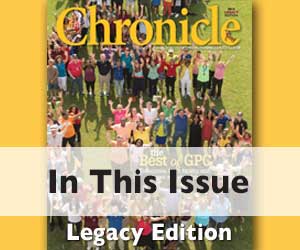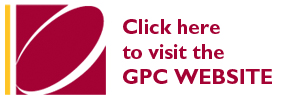
Fortunatus Chimaobi says from Georgia State’s predictive analytics and Keep HOPE Alive program have helped him stay in college. (photo by Leita Cowart)
by Kysa Anderson Daniels
Monica Robles-Frias credits dedication and discipline for her success as a straight-A student at Georgia State University, where she’s studying managerial science and keeping her social life to a minimal.
“I can’t go to sleep if I don’t do an assignment,” she says, laughing slightly. “I feel bad, if I don’t do something.”

Monica Robles-Frias’ disciplined approach to her studies has helped her maintain high grades at GPC and at Georgia State. (photo by Leita Cowart)
Self-control, she says, is a trait her parents passed along and one that has served her well—including during the two years she spent studying as an honors student at Georgia Perimeter College.
Student success like that demonstrated by Robles-Frias is the Holy Grail in institutions of higher education, particularly today when studies show that the demand for college-educated workers is outpacing graduation rates. Institutions are becoming more innovative to help students to succeed. They are strengthening student services, bolstering advising and intervention and using data to predict and monitor performance.
Eric Cuevas, assistant director for academic support and outreach at Georgia State, was working at Georgia Perimeter a few years ago when he met Robles-Frias through a program aimed at retaining and graduating Latino students. “Back then, she was a very shy, very quiet, unassuming little girl,” Cuevas recalls of the now 20-year-old.
When Robles-Frias and Cuevas met again at Georgia State she shared that, although she was making good grades, she didn’t feel connected at the university and was experiencing some ambiguity about her major. Cuevas challenged Robles-Frias to research companies that interested her. He also encouraged her to visit Georgia State’s Latino Student Services and Outreach (LASSO) office.
LASSO is an academic and social hub of sorts for all Georgia State students, but it especially targets Latinos, many who are first-generation college attendees and among those most at risk for not graduating. Latino student enrollment at Georgia State has exploded over the last several years, and LASSO provides an opportunity for students not only to socialize and network in a warm and inviting space, but also receive academic support, advisement, personal guidance and career advice. It also offers help with developing leadership and cultural skills among other services.
“We can be a kind of one-stop shop,” says Dylan Hart-Medina, LASSO coordinator.
Predictive analytics show the program is making a difference. “For Latino students who visit LASSO one or more times a semester, we find a significant difference in their GPAs,” Hart-Medina says. He says students visiting LASSO average a 3.31 grade-point average, compared to 3.01 for Latino students who don’t.
Cuevas says this signifies “a direct correlation between the use of our services and academic success.” In fact, a few years ago, Education Trust ranked Georgia State first in the nation in terms of graduating Hispanic students at a rate of 66 percent.
Data-Driven Success
Georgia State’s use of predictive analytics to boost graduation rates overall has thrust it into the national spotlight and is one of the major reasons cited for consolidating the university with Georgia Perimeter College. “We track the data, and if it looks like it’s working, we scale it up,” says Dr. Tim Renick, Georgia State University vice president for enrollment and student success.
Dr. Donald Pearl, Georgia Perimeter’s interim assistant vice president of academic affairs and college completion, is optimistic that already successful student support programs at GPC will become even stronger with the consolidation. He explains that Georgia State, through the Education Advisory Board, or EAB, has the ability to track information in a number of different combinations when determining how to assist students best.
“They’re able to take, frankly, millions of data points and do an analysis to make certain predictions,” he says, adding that GPC uses analytics but on a more basic level. “We do use data, just without the robust EAB kinds of services,” Pearl says.
Georgia State also is using predictive analytics in real time through an advising software system. The Banner system is updated nightly and ensures students are enrolled in the right courses for their major and are being advised correctly. For an example, the system flags students who score a C in a particular foundational class.
“In the past, we were sitting back and waiting until they took upper level courses,” Renick says. “By that time, they were usually stymied from their chosen major because of their grades. We realized that that first C grade means the students need help before they get to the more difficult material.”
Getting Back on Track
Georgia State sophomore Fortunatus Chimaobi benefited big-time from predictive analytics his first semester at the university. A couple of months before finals, college advisors sent him an email stating he was in danger of failing microbiology and suggesting he see his instructor right away and attend tutoring sessions.
“When I got that, I got scared,” he remembers. “I kicked it into high gear.” Chimaobi, 20, did avoid failing the class, but his grades weren’t high enough for him to maintain his HOPE scholarship. With a brother in college elsewhere in Georgia, Chimaobi feared his parents wouldn’t be able to pay the cost of him continuing at Georgia State and that he’d have to drop out.
But then, the aspiring medical researcher heard about Georgia State’s program called Keep HOPE Alive, which gives eligible students a $500 grant for two semesters, along with supplemental instruction, academic skills and financial literacy advisement.
Cuevas is mentoring Chimaobi through the process. They meet after each of Chimaobi’s exams to assess his strengths and weaknesses and how he can improve. Chimaobi says he’s also required to attend face-to-face and online sessions covering topics such as stress and money management.
Right now, it looks likely that Chimaobi will regain HOPE. “He’s doing a great job,” Cuevas says. “He’s on track, and that’s the mission of the program.”
Cuevas points to data showing students who lose the financial support of the HOPE scholarship graduate at half the rate of those who never had it in the first place. Georgia State reports that Keep HOPE Alive has helped 54 percent of students in the program regain the scholarship, compared to a 9 percent rate for students who lose the scholarship and don’t participate in the program.
Starting Over, Finishing Strong
Ebbie Willocks looks forward to graduating from Georgia Perimeter College this May, then starting at Georgia State in the summer. At 36, Willocks says he comes from a family that values education—but that didn’t translate into success for him when he first attended college years ago in North Carolina and his home state, New York.
Willocks eventually dropped out, took on a series of jobs in the entertainment and non-profit world and then, inspired by his mother and twin brother, decided to give college another try about six years ago.
“I realized that if you don’t have that piece of paper, people can just pull that rug from under you,” he says.

Ebbie Willocks, with Dr. Maggie Ehrlich, center, and Dr. Katrina Hunter, says Project R.A.I.S.E. helped him conquer his fear of math and move ahead in college. Dr. Ehrlich is GPC’s dean of mathematics, computer science and engineering. Dr. Hunter is director of Project R.A.I.S.E. (photo by Leita Cowart)
But starting over wasn’t easy. Anxiety over math hit hard and led him to one of Georgia Perimeter’s student success programs called Project R.A.I.S.E., or Raising Achievement and Increasing Success in Education. The retention and graduation initiative is funded by a grant awarded to GPC four years ago.
Willocks had tested into Learning Support math, which made him an ideal candidate for Project R.A.I.S.E., which particularly targets African American males who need assistance passing remedial math.
“I was just scared to death,” Willocks says of conquering his math challenges. But, thanks to a number of Project R.A.I.S.E. interventions, such as intensive tutoring sessions, academic coaching and workshops, Willocks tested out of Learning Support math.
“That did wonders for my confidence,” he says.
The program is working for others, too. From fall 2011 to fall 2013, the African American male retention rate at GPC rose from 37.8 to 56.3 percent. The goal had been 50 percent. In addition, students exiting Learning Support math in one semester and receiving an A, B or C in a collegiate level course increased from .9 percent in 2012 to 7 percent two years later.
Dr. Katrina Hunter, Project R.A.I.S.E. director, shares why she thinks the program is working.
“It replaces the traditional ‘one size fits all’ methodologies with more modernized approaches to learning while ensuring that the varying academic needs and learning styles of all students are acknowledged and addressed.”
Increasing Graduations
Even in the face of shrinking college graduation rates nationally, Georgia State is graduating 1,700 more students a year than it did five years ago, a 30 percent increase. Renick says the bulk of the gains have come from within at-risk student populations.
During the same time period, Georgia State saw a 59 percent increase in bachelor’s degrees conferred to African Americans, a 93 percent increase in degrees conferred to Pell Grant students and a 171 percent increase in degrees conferred to Hispanic/Latino students.
The categorical increases are outpacing (and contributing to) the rise in Georgia State’s total enrollment. The five-year period saw an overall enrollment increase of about 14 percent, which reflected a 4 percent hike in retention of students and a 10 percent surge in new students.
Renick says the increase in graduations, at least in part, can be attributed to Georgia State’s actions to analyze data, grow the college’s advisory staff and implement programs such as Keep HOPE Alive.
The statewide Complete College Georgia initiative is a motivating force behind the push to graduate more students like Willocks, Chimaobi and Robles-Frias. Its goal is to address Georgia’s workforce demands by graduating a quarter million students statewide over the next 10 years.
Pearl is optimistic that the consolidation between Georgia State and Georgia Perimeter will bring even bigger successes and increased graduation rates.
“We all feel positive that we can build off each other’s strengths,” he says.
With contributions from Rebecca Rakoczy.







No Comments on “Institutions Innovate to Help Students Succeed”